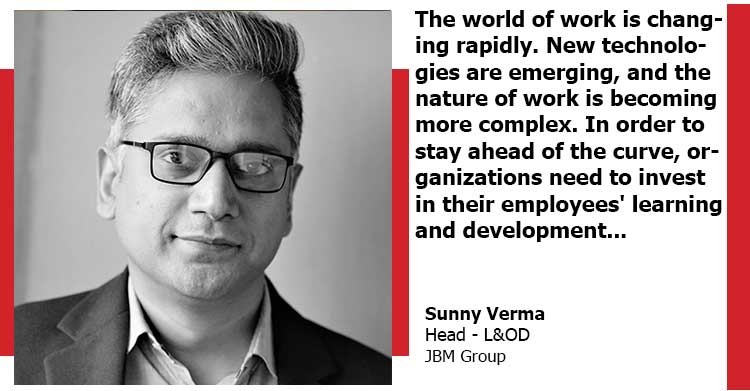The Future of Learning and Organizational Development | Sunny Verma | Head – L&OD | JBM Group

The world of work is changing rapidly. New technologies are emerging, and the nature of work is becoming more complex. In order to stay ahead of the curve, organizations need to invest in their employees’ learning and development.
There are a number of trends that are shaping the future of learning and organizational development. These trends include:
• The rise of artificial intelligence (AI). AI is already being used in learning and development in a number of ways, such as providing personalized feedback, automating tasks, and creating more engaging learning experiences. In the future, AI is likely to play an even greater role in learning and development, helping organizations to deliver more effective and efficient training.
• The focus on soft skills. In the future, soft skills such as communication, collaboration, and critical thinking will be increasingly important. These skills are not easily automated, and they are essential for success in today’s workplace. Organizations need to ensure that their employees have these skills to succeed.
• The emphasis on lifelong learning. In the future, learning will be a lifelong process. New technologies and new ways of working will emerge, and organizations need to ensure that their employees are prepared for these changes. This means that organizations need to create cultures that support continuous learning and development.
In addition to these trends, there are a number of other factors that are shaping the future of learning and organizational development. These factors include:
• The increasing demand for diversity and inclusion. Organizations need to ensure that their learning and development programs are inclusive and accessible to all employees.
• The need for globalized learning. In today’s globalized economy, organizations need to be able to train employees from all over the world. This means that learning and development programs need to be delivered in a variety of languages and cultures.
• The importance of data-driven learning. Organizations need to use data to track learner progress, identify areas for improvement, and personalize learning experiences.
These are just some of the trends that are shaping the future of learning and organizational development. As the world of work continues to change, organizations need to adapt their learning and development strategies to meet the needs of their employees.
How to Implement These Trends? So how can organizations implement these trends in their learning and development programs? Here are a few tips:
• Start by assessing your current needs. What are the skills gaps in your organization? What are the challenges that your employees are facing? Once you have a clear understanding of your needs, you can start to develop a learning and development strategy that addresses them.
• Invest in technology. Technology can play a powerful role in learning and development. There are a number of tools and platforms that can help you to deliver more effective and efficient training.
• Focus on soft skills. Soft skills are essential for success in today’s workplace. Make sure that your learning and development programs include a focus on these skills.
• Create a culture of lifelong learning. Learning should be a lifelong process. Encourage your employees to take advantage of opportunities to learn and develop throughout their careers.
• Use data to drive your decisions. Use data to track learner progress, identify areas for improvement, and personalize learning experiences.
By following these tips, you can help your organization to implement the latest trends in learning and organizational development. This will help you to ensure that your employees have the skills they need to succeed in today’s rapidly changing world.
Conclusion
The future of learning and organizational development is bright. By embracing the trends that are shaping the future, organizations can create learning and development programs that are effective, efficient, and inclusive. This will help them to build a workforce that is prepared for the challenges of the future
• Upskilling and reskilling: The pace of change in the workplace is accelerating, and organizations need to ensure that their employees have the skills they need to succeed. Upskilling and reskilling will be essential for organizations to stay competitive.
• Personalized learning: Learners are increasingly demanding personalized learning experiences that meet their individual needs and interests. Organizations that can provide personalized learning will be more successful at engaging and retaining their employees.
• Microlearning: Microlearning is a learning approach that delivers short bursts of information to learners. This is a great way to learn new skills or concepts quickly and easily.
• Gamification: Gamification is the use of game-like elements in non-game contexts. This can be a great way to make learning more engaging and fun.
• Collaborative learning: Collaborative learning is a learning approach that involves learners working together to learn. This can be a great way to share knowledge, build relationships, and solve problems.
• Virtual and augmented reality: Virtual and augmented reality (VR and AR) are emerging technologies that have the potential to revolutionize learning. VR can be used to create immersive learning experiences, while AR can be used to overlay digital information on the real world.
• Data-driven learning: Data-driven learning is the use of data to inform and improve learning. This can be done by tracking learner progress, identifying areas for improvement, and personalizing learning experiences.
These are just a few of the learning and development trends that are expected to emerge in 2023. As the workplace continues to change, organizations will need to adapt their learning and development strategies to meet the needs of their employees.


